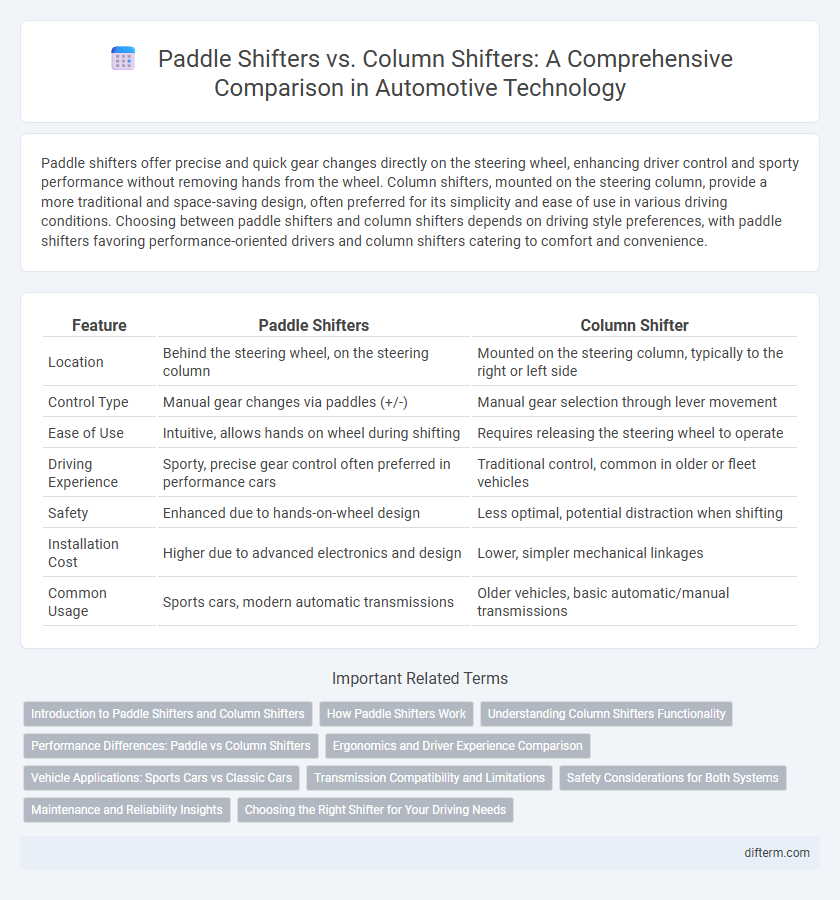Paddle shifters offer precise and quick gear changes directly on the steering wheel, enhancing driver control and sporty performance without removing hands from the wheel. Column shifters, mounted on the steering column, provide a more traditional and space-saving design, often preferred for its simplicity and ease of use in various driving conditions. Choosing between paddle shifters and column shifters depends on driving style preferences, with paddle shifters favoring performance-oriented drivers and column shifters catering to comfort and convenience.
Table of Comparison
| Feature | Paddle Shifters | Column Shifter |
|---|---|---|
| Location | Behind the steering wheel, on the steering column | Mounted on the steering column, typically to the right or left side |
| Control Type | Manual gear changes via paddles (+/-) | Manual gear selection through lever movement |
| Ease of Use | Intuitive, allows hands on wheel during shifting | Requires releasing the steering wheel to operate |
| Driving Experience | Sporty, precise gear control often preferred in performance cars | Traditional control, common in older or fleet vehicles |
| Safety | Enhanced due to hands-on-wheel design | Less optimal, potential distraction when shifting |
| Installation Cost | Higher due to advanced electronics and design | Lower, simpler mechanical linkages |
| Common Usage | Sports cars, modern automatic transmissions | Older vehicles, basic automatic/manual transmissions |
Introduction to Paddle Shifters and Column Shifters
Paddle shifters are user-friendly, behind-the-steering-wheel levers allowing manual gear changes without taking hands off the wheel, enhancing driving control and responsiveness. Column shifters, mounted on the steering column, provide a traditional gear selection method often found in trucks and older vehicles, offering easy access and simple operation. Both systems cater to different driving preferences, balancing convenience and performance in automotive transmission control.
How Paddle Shifters Work
Paddle shifters operate by electronically signaling the transmission control unit to shift gears when the driver pulls the left or right paddle mounted behind the steering wheel. These shifters enable quicker and more precise gear changes compared to traditional column shifters by allowing the driver to keep both hands on the wheel. Their integration with modern automatic and dual-clutch transmissions enhances driving dynamics and responsiveness on performance vehicles.
Understanding Column Shifters Functionality
Column shifters are mounted on the steering column and enable drivers to change gears without removing their hands from the steering wheel, enhancing control and safety. They operate through a mechanical linkage or electronic signal that selects the desired gear position, typically Park, Reverse, Neutral, Drive, and lower gears in automatic transmissions. Unlike paddle shifters that offer rapid gear changes by paddles behind the steering wheel, column shifters provide straightforward gear selection primarily designed for ease of use in everyday driving scenarios.
Performance Differences: Paddle vs Column Shifters
Paddle shifters enable quicker, more precise gear changes by allowing drivers to keep both hands on the steering wheel, enhancing control and performance during aggressive driving or racing scenarios. Column shifters often involve a longer mechanical linkage, resulting in slower shift response times and less direct feedback, which can impact driving dynamics negatively. Performance-oriented vehicles typically favor paddle shifters for their speed, ergonomic advantage, and seamless integration with automated transmissions.
Ergonomics and Driver Experience Comparison
Paddle shifters, positioned on the steering wheel, offer enhanced ergonomics by allowing drivers to change gears without removing their hands from the wheel, improving control and safety during dynamic driving situations. In contrast, column shifters require hand movement away from the wheel, potentially interrupting steering precision and increasing reaction time. The seamless gear changes facilitated by paddle shifters significantly elevate the driver experience in performance-oriented vehicles compared to the traditional column shifter design.
Vehicle Applications: Sports Cars vs Classic Cars
Paddle shifters are predominantly integrated into sports cars to facilitate rapid, seamless gear changes that enhance performance and driving dynamics. In contrast, column shifters are commonly found in classic cars, providing a more traditional and straightforward gear selection experience suited for relaxed driving. The choice between paddle shifters and column shifters reflects the vehicle's emphasis on either sporty precision or vintage authenticity.
Transmission Compatibility and Limitations
Paddle shifters are typically compatible with automatic and dual-clutch transmissions, allowing for faster gear changes and enhanced control during sporty or performance driving. Column shifters generally work with traditional automatic or manual transmissions but may lack the precision and quick response found in paddle shifters. Limitations of paddle shifters include potential incompatibility with older transmission systems, while column shifters can restrict driver engagement and shifting speed.
Safety Considerations for Both Systems
Paddle shifters offer enhanced driver control by allowing gear changes without removing hands from the steering wheel, reducing distraction and improving reaction time in critical situations. Column shifters, traditionally positioned away from the steering wheel, may require more driver attention to operate, potentially increasing the risk of delayed response during emergency maneuvers. Both systems must adhere to ergonomic design and placement standards to minimize accidental gear shifts and ensure driver safety.
Maintenance and Reliability Insights
Paddle shifters, integrated into the steering wheel, generally require less mechanical maintenance due to their electronic actuation compared to column shifters, which involve more physical linkage components prone to wear and calibration issues. Reliability studies indicate paddle shifters exhibit fewer failure points, reducing the frequency of repairs and ensuring consistent performance over time. However, electronic components in paddle shifters can be susceptible to sensor malfunctions, whereas column shifters often face mechanical fatigue, making component quality a crucial factor in long-term durability for both systems.
Choosing the Right Shifter for Your Driving Needs
Paddle shifters offer quick, precise gear changes ideal for performance driving and sporty cars, enhancing control without taking hands off the wheel. Column shifters provide a classic, ergonomic design suited for comfort and ease of use in everyday driving, especially in larger vehicles or trucks. Selecting the right shifter depends on your driving style, vehicle type, and preference for either dynamic responsiveness or traditional functionality.
Paddle shifters vs Column shifter Infographic

 difterm.com
difterm.com